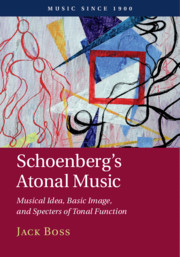Book contents
- Schoenberg’s Atonal Music
- Music Since 1900
- Schoenberg’s Atonal Music
- Copyright page
- Dedication
- Contents
- Music Examples
- Acknowledgments
- Abbreviations and Notational Conventions
- 1 Tonal oder Atonal?
- 2 Piano Pieces Op. 11, Nos. 2 and 3
- 3 Das Buch der hängenden Gärten, Op. 15, Nos. 7 and 11
- 4 Erwartung, Op. 17
- 5 Six Little Piano Pieces, Op. 19 (Nos. 2, 3, and 6)
- 6 Pierrot lunaire, Op. 21, Nos. 1, 14, and 21
- 7 Summary, and the Way Forward to Twelve-Tone Music
- Bibliography
- Index
- By the same author
2 - Piano Pieces Op. 11, Nos. 2 and 3
The Latter Movements of a Remarkably Progressive Cycle
Published online by Cambridge University Press: 28 June 2019
- Schoenberg’s Atonal Music
- Music Since 1900
- Schoenberg’s Atonal Music
- Copyright page
- Dedication
- Contents
- Music Examples
- Acknowledgments
- Abbreviations and Notational Conventions
- 1 Tonal oder Atonal?
- 2 Piano Pieces Op. 11, Nos. 2 and 3
- 3 Das Buch der hängenden Gärten, Op. 15, Nos. 7 and 11
- 4 Erwartung, Op. 17
- 5 Six Little Piano Pieces, Op. 19 (Nos. 2, 3, and 6)
- 6 Pierrot lunaire, Op. 21, Nos. 1, 14, and 21
- 7 Summary, and the Way Forward to Twelve-Tone Music
- Bibliography
- Index
- By the same author
Summary
Chapter 2 demonstrates how the second and third Piano Pieces of Op. 11 form a cycle together with the first, in that they take up motives, harmonies, and processes that were introduced in the first piece, and use them to create narratives of conflict, elaboration, and solution – “musical ideas.” Op. 11’s processes include an expansion of pitch intervals within motives that generalizes into an expansion of pitch-class intervals within set classes, and an “explanatory” process that shows how unfamiliar pitch-interval collections can be reconciled to familiar motives through set-class identity with them. In Op. 11, No. 2, a conflict between set classes and motives similar to the one found in Op. 11, No. 1, is elaborated and resolved using the “explanatory” process, among other devices. In Op. 11, No. 3, the expanding and explanatory processes exist side by side in conflict, but rather than coming together in a solution, the expanding process simply crowds out the explanatory one, so that the “musical idea” is incomplete. My analysis of Op. 11, No. 3, pushes back against the common notion of the piece as “athematic,” in that it portrays the piece as a battle of motivic processes.
Keywords
- Type
- Chapter
- Information
- Schoenberg's Atonal MusicMusical Idea, Basic Image, and Specters of Tonal Function, pp. 41 - 110Publisher: Cambridge University PressPrint publication year: 2019

